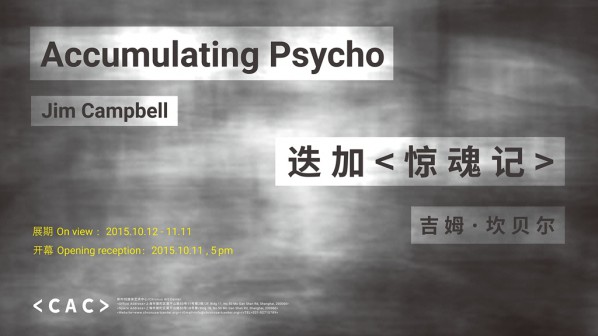
Accumulating Psycho features one video that documents the process of the continual averaging and accumulation of all the frames of Hitchcock’s classic Psycho, whereby the entire 1 hour, 50 minutes film is collapsed into one single image while the sound remains intact. As the algorithm disperses the original brightness and contrast data of the digitized film, an image of the crunching, averaging work of the algorithm accumulates whereas the massive visual data of the film is scattered and discarded or simply overwritten, rendering the effect of a phantasmagoric display as if one were viewing the film’s accelerated generational degradation or the light from the film’s projection slowly creeping into the being of the image itself.
Campbell’s work mangles Psycho and wrenches the film from 20th century psychic structures bounded by classic narrative cinema into 21th century data visualization and manipulation. It investigates the persistent, temporal modulations of computation, and by averaging the entire information content of the digitized film, it rends an uncanny blemish from the heart of the digital itself. The resulted single image, realized as Psycho’s temporality collapsed into a superimposed, captured instant, embraces the static ontology of the photograph; it operates as an index of digital space, and connects with the digital as an index of a seemingly imperceptible space.
As Walter Benjamin famously wrote, “memory is not an instrument for exploring the past but its theater,” Accumulating Psycho recollects and interprets by averaging the monolith of cultural memory stored in the film as specific, precise data, transforming it, staging it in present experience; this transformation intervenes by devouring this memory, erasing its perceptual vividness by literally overwriting it with fuzzy averages - condensations of computational memory.
Accumulating Psycho
Jim Campbell|2004|DVD
In 1999 I started a series of works that were sort of experiments in that I had no idea what the end result would be. The concept was to mathematically average all of the frames of a film into a single still image without any processing or unequal weighting. I started with the film Psycho and soon realized that with that many frames averaged together I would need to add contrast to the final image otherwise I would simply end up with a gray field. When the accumulation of all of the images was complete, I was quite surprised to see recognizable objects in the end result. A telephone, a pitcher of water, curtains and other objects were visible. This was because Hitchcock used many long takes in the film. My background was in hardware engineering and as such the method that I used to create these works was to build a hardware averaging circuit. This circuit took video in and after the length of the film would put out a single frame to the computer. The circuit that I built to create these works allowed me to see the accumulation process in real time as the frames were building up. The process of creating the averaged image was as interesting as the end result. This led to the work Accumulating Psycho. The added element of the audio allows the viewer to know which part of the film they are viewing since the visual is changing so slowly... allowing the viewers to use their imagination to see what they think they are seeing.
About the Artist
Jim Campbell (b. 1956).
Campbell’s work has been exhibited internationally and throughout North America in institutions such as the Whitney Museum of American Art, New York; The San Francisco Museum of Modern Art; The International Center for Photography, New York; The J. Paul Getty Museum, Los Angeles and The Museum of Contemporary Art, Sydney, Australia. His electronic art work is included in the permanent collections of the Museum of Modern Art, New York; the Smithsonian American Art Museum, Washington, DC; the Whitney Museum of American Art; the Metropolitan Museum of Art, New York; the San Francisco Museum of Modern Art; the de Young Museum, San Francisco and the Berkeley Art Museum. In 2012, he was the recipient of the San Francisco Museum of Modern Art’s 13th Annual Bay Area Treasure Award. Previous honors include a Rockefeller Foundation Fellowship Award in Multimedia, three Langlois Foundation Grants and a Guggenheim Fellowship Award.
Campbell has two Bachelor of Science Degrees in Mathematics and Engineering from MIT and as an engineer holds nearly twenty patents in the field of video image processing. A monograph of his work, Material Light, was published by Hatje Cantz in 2010.
About the Series
Accumulating Psycho is the sixth exhibition in a series of screen-based works organized by the Chronus Art Center. Conceived by ZHANG Ga, this exhibition series examines, through seven international artists’ projection works, each presented in a month-long solo exhibition, dynamically generated audiovisual systems that artists have custom-made, real-time transmitted images which demand protocols other than those readily available, idiosyncratic animation techniques for which given rules will be rewritten, and subject matters estranged from the populist safe haven. The artists presented in this series often exploit an algorithmic logic distinct from the predominant language that speaks the parlance of video art—software presets and editing routines for visual manipulation and content authoring—thereby disrupting and sabotaging the economy and the ideology of image production implicit in the very tools and means that produce narrative and construct meaning. In doing so, they have developed a new aesthetic sensibility beyond the received notion of video art as such, extending the rich tradition of media art seen in the pioneering experiments of Walter Ruttmann and Dziga Vertov of the 1920s; by the canonical works of Michael Snow, the Vasulkas and Nam June Paik, to name just a few, of the mid-century; to the digital contemporary, and opened new potentials for tending individuated perceptual spaces that can acculturate the spectacles of cosmic magnitude and the facticity of the everyday, imagined or otherwise.
About the exhibition
On view: 2015.10.12-11.11
Opening reception: 2015.10.11, 5pm
Venue: Chronus Art Center
Address: BLDG.18, No.50 Moganshan RD., Shanghai
Courtesy of the artist and Chronus Art Center.




























